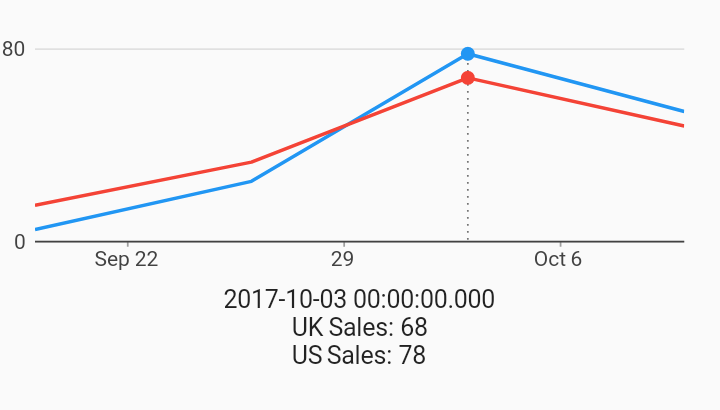charts
Selection Callback Example Interactions Example

Example:
/// Timeseries chart with example of updating external state based on selection.
///
/// A SelectionModelConfig can be provided for each of the different
/// [SelectionModel] (currently info and action).
///
/// [SelectionModelType.info] is the default selection chart exploration type
/// initiated by some tap event. This is a different model from
/// [SelectionModelType.action] which is typically used to select some value as
/// an input to some other UI component. This allows dual state of exploring
/// and selecting data via different touch events.
///
/// See [SelectNearest] behavior on setting the different ways of triggering
/// [SelectionModel] updates from hover & click events.
import 'package:charts_flutter/flutter.dart' as charts;
import 'package:flutter/material.dart';
class SelectionCallbackExample extends StatefulWidget {
final List<charts.Series> seriesList;
final bool animate;
SelectionCallbackExample(this.seriesList, {this.animate});
/// Creates a [charts.TimeSeriesChart] with sample data and no transition.
factory SelectionCallbackExample.withSampleData() {
return new SelectionCallbackExample(
_createSampleData(),
// Disable animations for image tests.
animate: false,
);
}
// We need a Stateful widget to build the selection details with the current
// selection as the state.
@override
State<StatefulWidget> createState() => new _SelectionCallbackState();
/// Create one series with sample hard coded data.
static List<charts.Series<TimeSeriesSales, DateTime>> _createSampleData() {
final us_data = [
new TimeSeriesSales(new DateTime(2017, 9, 19), 5),
new TimeSeriesSales(new DateTime(2017, 9, 26), 25),
new TimeSeriesSales(new DateTime(2017, 10, 3), 78),
new TimeSeriesSales(new DateTime(2017, 10, 10), 54),
];
final uk_data = [
new TimeSeriesSales(new DateTime(2017, 9, 19), 15),
new TimeSeriesSales(new DateTime(2017, 9, 26), 33),
new TimeSeriesSales(new DateTime(2017, 10, 3), 68),
new TimeSeriesSales(new DateTime(2017, 10, 10), 48),
];
return [
new charts.Series<TimeSeriesSales, DateTime>(
id: 'US Sales',
domainFn: (TimeSeriesSales sales, _) => sales.time,
measureFn: (TimeSeriesSales sales, _) => sales.sales,
data: us_data,
),
new charts.Series<TimeSeriesSales, DateTime>(
id: 'UK Sales',
domainFn: (TimeSeriesSales sales, _) => sales.time,
measureFn: (TimeSeriesSales sales, _) => sales.sales,
data: uk_data,
)
];
}
}
class _SelectionCallbackState extends State<SelectionCallbackExample> {
DateTime _time;
Map<String, num> _measures;
// Listens to the underlying selection changes, and updates the information
// relevant to building the primitive legend like information under the
// chart.
_onSelectionChanged(charts.SelectionModel model) {
final selectedDatum = model.selectedDatum;
DateTime time;
final measures = <String, num>{};
// We get the model that updated with a list of [SeriesDatum] which is
// simply a pair of series & datum.
//
// Walk the selection updating the measures map, storing off the sales and
// series name for each selection point.
if (selectedDatum.isNotEmpty) {
time = selectedDatum.first.datum.time;
selectedDatum.forEach((charts.SeriesDatum datumPair) {
measures[datumPair.series.displayName] = datumPair.datum.sales;
});
}
// Request a build.
setState(() {
_time = time;
_measures = measures;
});
}
@override
Widget build(BuildContext context) {
// The children consist of a Chart and Text widgets below to hold the info.
final children = <Widget>[
new SizedBox(
height: 150.0,
child: new charts.TimeSeriesChart(
widget.seriesList,
animate: widget.animate,
selectionModels: [
new charts.SelectionModelConfig(
type: charts.SelectionModelType.info,
listener: _onSelectionChanged,
)
],
)),
];
// If there is a selection, then include the details.
if (_time != null) {
children.add(new Padding(
padding: new EdgeInsets.only(top: 5.0),
child: new Text(_time.toString())));
}
_measures?.forEach((String series, num value) {
children.add(new Text('${series}: ${value}'));
});
return new Column(children: children);
}
}
/// Sample time series data type.
class TimeSeriesSales {
final DateTime time;
final int sales;
TimeSeriesSales(this.time, this.sales);
}